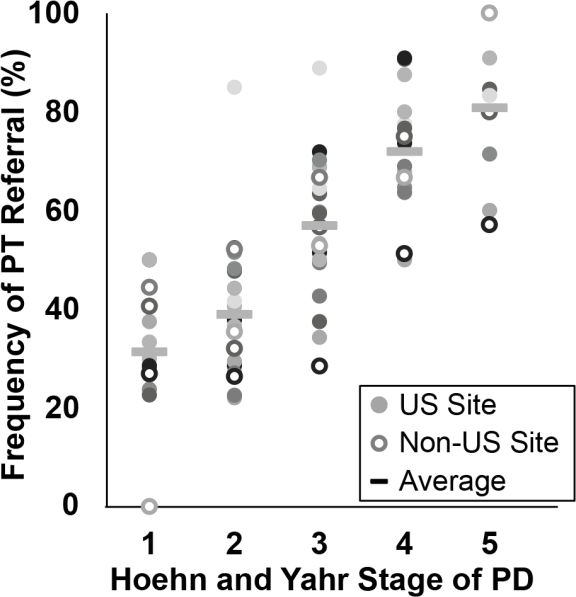Session Information
Date: Monday, June 20, 2016
Session Title: Epidemiology
Session Time: 12:30pm-2:00pm
Location: Exhibit Hall located in Hall B, Level 2
Objective: To (1) describe current variability in physical therapy (PT) use by people with Parkinson’s disease (PD) and to (2) examine the association between PT use and patient outcomes.
Background: PT is a well-supported intervention for people in all stages of PD; however little is known about current PT use. Knowledge of PT use and outcomes should be established prior to development, adaptation, and systematic implementation of PT guidelines for people with PD in the US.
Methods: QII is a longitudinal observational study of PD patients (n=8041) at 21 expert care clinics. PT use (self-reported referrals in past year) was measured at each Hoehn and Yahr stage (HY) of PD at the second QII visit to reflect care delivered at the NPF clinic (n=5239). At each HY stage, PT users and non-users were compared, with Bonferroni correction, on the following measures: age, disease duration, exercise, mobility (Timed Up and Go), health-related quality of life (HRQL; Parkinson’s disease Questionnaire-39), hospitalizations, and falls. Then sites were ranked using a global outcome (z-score of mobility, HRQL, cognition, hospitalizations, and caregiver strain), and PT use was compared between the top and bottom third of all sites.
Results: High variability in PT use occurred at all HY stages in the US and elsewhere (Figure 1). PT use was greatest in HY 5 (mean 81%, range 57-100%) and lowest in HY 1 (31%, 0-50%). There were no differences between PT users and non-users at HY stages 1 and 5. In HY 2 and 3 PT users were older, had worse mobility, more hospitalizations and more falls (p<0.0001). In HY 2, PT users also had significantly worse HRQL and longer disease durations (p<0.006). In HY 4, PT users reported more hospitalizations (p<0.0001). When sites were ranked using the global outcome, the top performing sites had greater PT use than the bottom third (44.7% to 36.9%, Chi-Sq=8.8 (df 1), p= 0.003). 
Conclusions: PT use was highly variable in all stages of PD, with peak use in advanced PD. In moderate PD, PT use was associated with worse mobility, hospitalizations, and falls, which reflects reactive versus preventive PT use. Higher rates of PT use at higher performing sites and high practice variability supports future systematic implementation studies of PT guidelines for PD.
To cite this abstract in AMA style:
M.R. Rafferty, P.N. Schmidt, S.T. Luo, K. Li, F. Cubillos, C. Marras, T. Davis, E.C. Nelson, T. Simuni. Physical therapy practice variability and outcomes for people with Parkinson’s disease: Data from the National Parkinson Foundation quality improvement initiative (NPF-QII) [abstract]. Mov Disord. 2016; 31 (suppl 2). https://www.mdsabstracts.org/abstract/physical-therapy-practice-variability-and-outcomes-for-people-with-parkinsons-disease-data-from-the-national-parkinson-foundation-quality-improvement-initiative-npf-qii/. Accessed December 30, 2025.« Back to 2016 International Congress
MDS Abstracts - https://www.mdsabstracts.org/abstract/physical-therapy-practice-variability-and-outcomes-for-people-with-parkinsons-disease-data-from-the-national-parkinson-foundation-quality-improvement-initiative-npf-qii/
